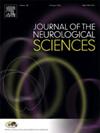Impact of blood viscosity on wake-up stroke: Analysis stratified by age and stroke subtype
IF 3.6
3区 医学
Q1 CLINICAL NEUROLOGY
引用次数: 0
Abstract
Objective
Ischemic stroke occurring during sleep is termed wake-up stroke (WUS). Dehydration increases blood viscosity (BV) and evokes thrombogenesis, a common cause of WUS. This study aimed to investigate the association between BV and WUS, stratified by age and stroke subtype.
Methods
The subjects were consecutive patients with acute ischemic stroke onset-to-door time within 72 h. Hematocrit-derived BV at a high shear rate (300 s−1) was calculated using hematocrit at admission. We assessed association of BV with WUS in the whole cohort, stratified by age (elderly group, ≥65 years; younger group, <65 years) and by stroke subtype (small-vessel occlusion [SVO], large-artery atherosclerosis [LAA], cardioembolism [CE]) stratified by age.
Results
We included 1362 acute ischemic stroke patients (975 [72 %] male, median age 69 years). WUS was observed in 326 (24 %) patients. Multivariable logistic regression in the whole cohort showed no association of BV with WUS (OR 1.163, 95 %CI 0.925–1.462, p = 0.197). Higher BV was significantly associated with WUS in the elderly group (OR 1.455, 95 % CI 1.080–1.959, p = 0.014) but not the younger group (OR 0.848, 95 %CI 0.568–1.268, p = 0.423). Among the stroke subtypes, higher BV was associated with WUS only in SVO (all ages: OR 2.316, 95 %CI 1.251–4.288, p = 0.008; elderly group: OR 2.427, 95 %CI 1.011–5.821, p = 0.047; younger group: OR 3.190, 95 %CI 1.131–8.544, p = 0.028).
Conclusions
Higher BV contributed to WUS in elderly patients. Among the stroke subtypes, higher BV was associated with WUS only in SVO.
血液粘度对醒脑的影响:按年龄和脑卒中亚型分层分析
目的在睡眠中发生的缺血性中风被称为唤醒性中风(WUS)。脱水会增加血液粘度(BV)并引起血栓形成,这是WUS的常见原因。本研究旨在通过年龄和脑卒中亚型来探讨脑容积与WUS之间的关系。方法研究对象为急性缺血性卒中发病至入院时间72h内的连续患者,采用入院时的血细胞比容计算高剪切速率(300 s−1)下的血细胞比容衍生BV。我们评估了整个队列中BV与WUS的相关性,并按年龄分层(老年组,≥65岁;年轻组,65岁)和按年龄分层的中风亚型(小血管闭塞[SVO],大动脉粥样硬化[LAA],心脏栓塞[CE])。结果纳入1362例急性缺血性脑卒中患者,其中975例(72%)为男性,中位年龄69岁。326例(24%)患者出现WUS。整个队列的多变量logistic回归显示BV与WUS无相关性(OR 1.163, 95% CI 0.925-1.462, p = 0.197)。高BV与WUS在老年组显著相关(OR 1.4555, 95% CI 1.080-1.959, p = 0.014),而在年轻组无显著相关性(OR 0.848, 95% CI 0.568-1.268, p = 0.423)。在卒中亚型中,高BV仅在SVO中与WUS相关(所有年龄:OR 2.316, 95% CI 1.251-4.288, p = 0.008;老年组:OR 2.427, 95% CI 1.011 ~ 5.821, p = 0.047;年轻组:OR 3.190, 95% CI 1.131 ~ 8.544, p = 0.028)。结论BV升高是老年WUS发病的原因之一。在卒中亚型中,高BV仅在SVO中与WUS相关。
本文章由计算机程序翻译,如有差异,请以英文原文为准。
求助全文
约1分钟内获得全文
求助全文
来源期刊

Journal of the Neurological Sciences
医学-临床神经学
CiteScore
7.60
自引率
2.30%
发文量
313
审稿时长
22 days
期刊介绍:
The Journal of the Neurological Sciences provides a medium for the prompt publication of original articles in neurology and neuroscience from around the world. JNS places special emphasis on articles that: 1) provide guidance to clinicians around the world (Best Practices, Global Neurology); 2) report cutting-edge science related to neurology (Basic and Translational Sciences); 3) educate readers about relevant and practical clinical outcomes in neurology (Outcomes Research); and 4) summarize or editorialize the current state of the literature (Reviews, Commentaries, and Editorials).
JNS accepts most types of manuscripts for consideration including original research papers, short communications, reviews, book reviews, letters to the Editor, opinions and editorials. Topics considered will be from neurology-related fields that are of interest to practicing physicians around the world. Examples include neuromuscular diseases, demyelination, atrophies, dementia, neoplasms, infections, epilepsies, disturbances of consciousness, stroke and cerebral circulation, growth and development, plasticity and intermediary metabolism.
 求助内容:
求助内容: 应助结果提醒方式:
应助结果提醒方式:


